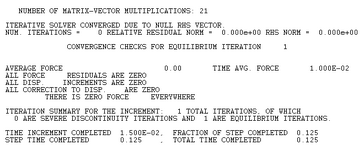ShiningEngineer
Student
Hello dear community,
I would like to transfer a seat pressure distribution into my simulation model.
I have already been able to validate my hyperelastic material in previous studies by comparing it to experimental studies.
I would like to import my seat pressure data from a seat pressure measurement (N/mm²) into Abaqus and reconstruct it. My problem is the load definition.
Attached are screenshots that should explain my problem as an example. For a better overview and initial approaches, I have only loaded 2-4 seating data into my simulation model.
In case 1) Load via a concentrated force, I am able to transfer the seat pressure data to my simulation model after converting it to Newtons. However, the problem here is that the force is loaded via the element nodes on the surface. Neighboring elements will share the nodes, if necessary I will research again whether tetrahedron elements are more suitable. A workflow for creating an imaginary element node in the middle of each element set probably doesn't exist in Abaqus, does it?
Probably the most elegant way to load a seating pressure distribution is to use a discrete field in case 2). Here, after reading the element IDs on the surface, I can directly define the pressure in N/mm² via component 1. According to the Abaqus documentation for discrete fields, the magnitude is a scaling factor and is specified as 1, did I understand that correctly? Unfortunately, my simulation starts without error messages but without results. I don't understand where my error is.
In case 3) I tried to create the pressure over the defined element surface. Here my simulation does not start at all, does anyone have a hint why?
I use the SI unit system in mm:
My model is defined in mm,
Pressure in N/mm²
Force in Newton.
I am firmly convinced that my model is realistic and conforms to units, otherwise the first case and the preliminary investigations would not provide valid results.
I would be very grateful for any advice, suggestions and, if necessary, small tips for reading in.
Best regards
I would like to transfer a seat pressure distribution into my simulation model.
I have already been able to validate my hyperelastic material in previous studies by comparing it to experimental studies.
I would like to import my seat pressure data from a seat pressure measurement (N/mm²) into Abaqus and reconstruct it. My problem is the load definition.
Attached are screenshots that should explain my problem as an example. For a better overview and initial approaches, I have only loaded 2-4 seating data into my simulation model.
In case 1) Load via a concentrated force, I am able to transfer the seat pressure data to my simulation model after converting it to Newtons. However, the problem here is that the force is loaded via the element nodes on the surface. Neighboring elements will share the nodes, if necessary I will research again whether tetrahedron elements are more suitable. A workflow for creating an imaginary element node in the middle of each element set probably doesn't exist in Abaqus, does it?
Probably the most elegant way to load a seating pressure distribution is to use a discrete field in case 2). Here, after reading the element IDs on the surface, I can directly define the pressure in N/mm² via component 1. According to the Abaqus documentation for discrete fields, the magnitude is a scaling factor and is specified as 1, did I understand that correctly? Unfortunately, my simulation starts without error messages but without results. I don't understand where my error is.
In case 3) I tried to create the pressure over the defined element surface. Here my simulation does not start at all, does anyone have a hint why?
I use the SI unit system in mm:
My model is defined in mm,
Pressure in N/mm²
Force in Newton.
I am firmly convinced that my model is realistic and conforms to units, otherwise the first case and the preliminary investigations would not provide valid results.
I would be very grateful for any advice, suggestions and, if necessary, small tips for reading in.
Best regards















